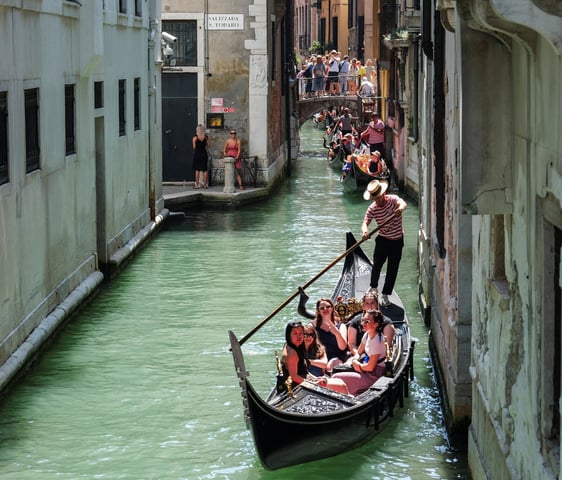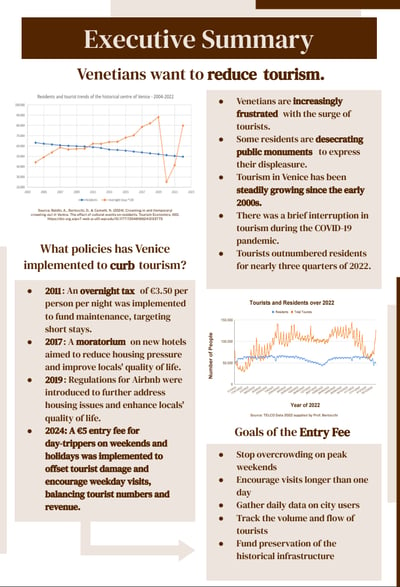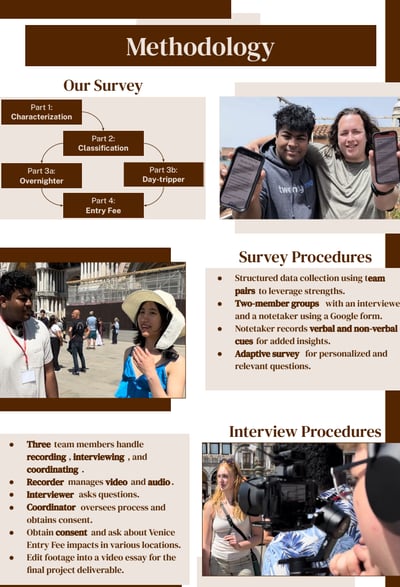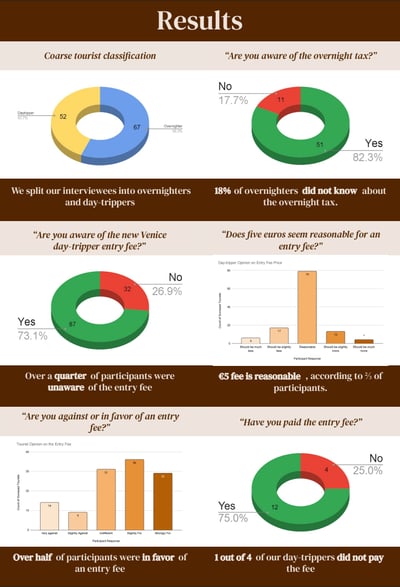IQP: Exploring Venice's Tourist Entry Fee
Our team studied the impacts of Venice's new tourist entry fee, aimed at managing overcrowding and enhancing the city's maintenance while promoting weekday visits for a sustainable tourism experience.


Venice Project
Background: The Venice Entry Fee
Venice has long struggled with overtourism, which has put immense pressure on the city’s infrastructure and diminished the quality of life for residents. To combat these issues, the local government introduced several regulatory measures over the past decade, including:
A 2011 overnight tax to generate revenue from short-term visitors.
A 2017 hotel moratorium to prevent further expansion of tourist accommodations.
2019 regulations on Airbnb rentals to curb the conversion of residential properties into short-term vacation stays.
The 2024 tourist entry fee, a €5 charge imposed on day-trippers during peak weekends and holidays.
The primary goals of the 2024 entry fee were to deter excessive influx during peak times, encourage longer stays, gather data on visitor flows, and generate funds for the maintenance of Venice’s historic infrastructure. However, the effectiveness of this measure remained uncertain, as concerns arose regarding its impact on tourist behavior, enforcement, and economic viability.
Project Objectives
Our project aimed to evaluate the effectiveness and reception of the entry fee by focusing on three key areas:
Tourist Awareness and Perception: Understanding whether visitors were aware of the fee before arrival and their opinions on its fairness and impact.
Impact on Tourist Behavior: Examining whether the fee influenced travel decisions, such as visit duration and spending habits.
Effectiveness of Communication and Enforcement: Assessing how well the city informed tourists about the fee and whether visitors complied with the requirement.
Methodology
To collect meaningful data, we designed a multi-method research approach that combined surveys and interviews:
Surveys: We conducted 119 exit surveys at key tourist locations, including San Marco, Rialto, and Academia, targeting both overnighters and day-trippers. The survey covered aspects such as tourist demographics, awareness of the fee, willingness to pay, and opinions on its purpose and implementation.
Interviews: We supplemented the surveys with semi-structured interviews, capturing in-depth responses about the emotional and behavioral impact of the tax. These interviews helped us better understand visitor sentiment and the broader implications of the fee.
Video Documentation: In addition to the data collection, we filmed select interviews to create a video essay, providing a visual representation of tourist perspectives.
Key Findings
Our research yielded several notable insights regarding the entry fee’s reception, effectiveness, and challenges:
1. Awareness and Compliance Issues
While over 65% of tourists surveyed considered the €5 fee reasonable, over a quarter of respondents were unaware of the fee before arrival.
Compliance was inconsistent: Among the 16 day-trippers required to pay on the surveyed days, only 12 (75%) actually did so.
Many tourists reported difficulty in finding clear information about the fee, despite the city’s efforts to promote it through billboards, transport signs, and online platforms.
Tourists learned about the fee from various sources, with online platforms, word of mouth, and news outlets being the most common. However, these methods lacked consistency, leading to misinformation and confusion.
2. Impact on Tourist Behavior
Despite its goal of deterring peak-time visitation, the fee did not significantly alter tourist numbers, suggesting that €5 was too low to influence travel decisions.
While some visitors expressed mild annoyance, most considered the fee an insignificant expense compared to their total trip costs.
Tourists already planning overnight stays were generally unaffected, while day-trippers largely viewed the fee as an expected cost rather than a deterrent.
3. Economic and Social Implications
The entry fee generated €1.7 million within the first 21 days of implementation, which partially offset the €3 million initial cost of rollout.
Local businesses showed mixed reactions—some welcomed the extra funding for city maintenance, while others feared it could discourage budget-conscious visitors.
Venetian residents expressed frustration that the fee did not meaningfully address overcrowding, as peak weekend congestion remained high.
Challenges and Controversies
While the fee was designed to regulate tourism and preserve Venice’s historic integrity, several issues arose:
Lack of enforcement: The fee relied on random police checks, which led to many tourists entering without paying.
Exemption loopholes: Many “proper excursionists” (those traveling from nearby cities like Mestre) were exempt, even though they contributed significantly to congestion.
Tourism industry backlash: Some travel companies criticized the fee as a “symbolic gesture” rather than an effective strategy, arguing that stricter visitor limits or reservation systems might be more impactful.
Recommendations
Based on our findings, we proposed several strategies to improve the entry fee system:
Enhance communication efforts: Increase visibility at transit hubs (train stations, bus terminals) and provide multilingual digital resources to ensure broader awareness.
Strengthen enforcement: Implement automated kiosks and QR codes for easier payment, while increasing penalties for non-compliance.
Adjust pricing strategy: Consider a dynamic pricing model, where fees fluctuate based on demand (e.g., higher fees on peak weekends).
Expand data collection: Leverage the entry fee system to gather real-time tourist flow analytics for better crowd management.
Involve local businesses and residents: Create community engagement programs to ensure funds are used transparently for infrastructure improvements.
Conclusion
Our research highlighted that while Venice’s entry fee successfully generated revenue, it fell short of deterring tourist influx on peak days. The city must refine its communication, enforcement, and pricing strategies to better achieve its goals of reducing congestion and promoting sustainable tourism. As the trial period continues, our recommendations could help Venice optimize the system for long-term success while balancing the interests of tourists, residents, and the local economy.
Through this IQP, I gained firsthand experience in urban tourism management, data analysis, and public policy evaluation, while contributing to a pressing issue in one of the world’s most visited cities. This project deepened my understanding of how cities can navigate the complexities of tourism regulation and provided valuable insights into policy implementation, economic sustainability, and public perception analysis.






Video Report
As part of our project, we created a video essay to complement our research and bring our findings to life. Filmed at major tourist spots in Venice, the video features interviews with visitors about their awareness and opinions of the new entry fee. It helped capture the emotional and personal side of our data—showing how tourists felt about overtourism, the fairness of the fee, and whether they thought it would make a difference. The video also documented our survey process and served as an engaging way to share our work with both our sponsor and future IQP teams.

About
Showcasing my journey in mechanical engineering.
Contact ME
marcgk25@gmail.com
+1(347)-265-6614
© 2025. All rights reserved.